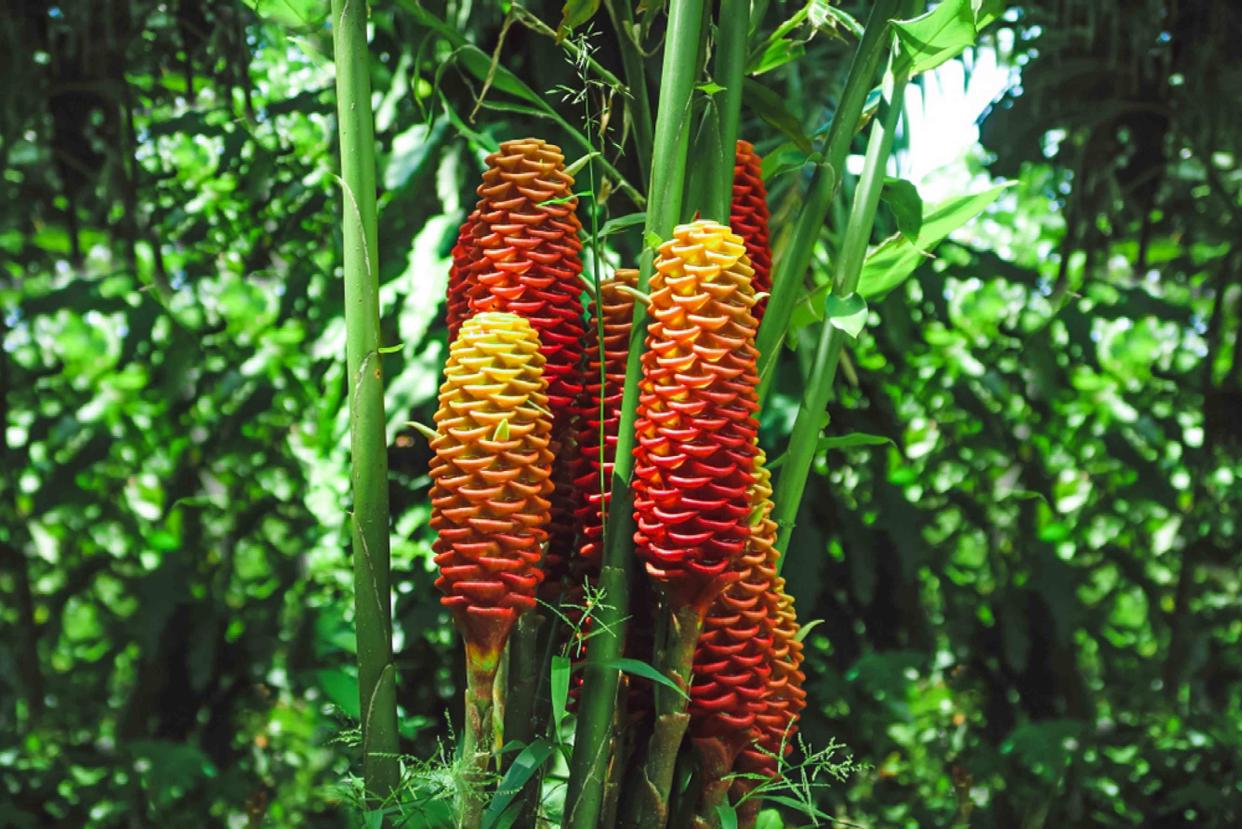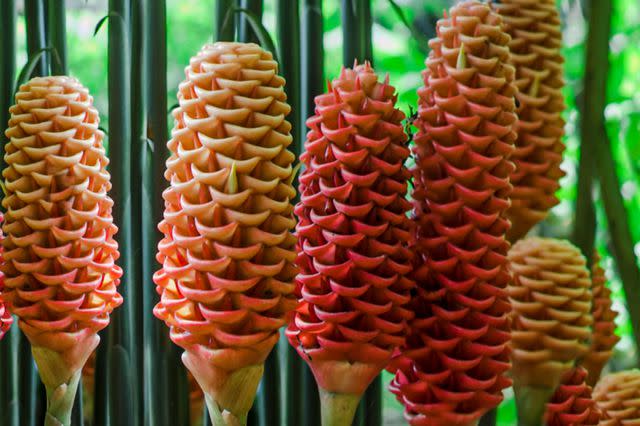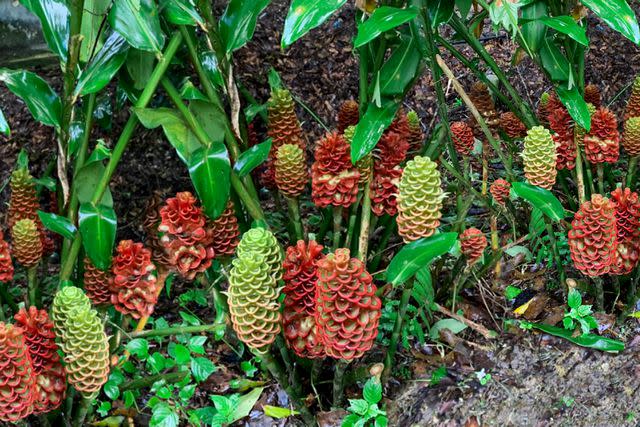How to Grow and Care For Beehive Ginger

The Spruce / K. Dave
It's difficult to find a more showy and unusual tropical flower than the beehive ginger (Zingiber spectabile). Beehive ginger thrives in warm, frost-free climates similar to its native habitats in southeast Asia. Like other plants in the Zingiber genus, the cone-like bracts, which are not anatomically flowers, are much showier than the actual flowers, which protrude from the bracts. Beehive ginger is perfect for creating long-lasting tropical cut flower arrangements.
Common Name | Beehive ginger |
Botanical Name | Zingiberspectabile |
Family | Zingiberaceae |
Plant Type | Herbacious, perennial |
Mature Size | 6-8 ft. tall, 2-5 ft. wide |
Sun Exposure | Full, partial |
Soil Type | Well-drained |
Soil pH | Acidic, neutral |
Bloom Time | Fall, summer |
Flower Color | Purple, red, pink |
Hardiness Zones | 9-11 (USDA) |
Native Areas | Asia |
Beehive Ginger Care
If you are new to growing tropical flowers, you could hardly find an easier or more rewarding candidate to start with than the beehive ginger. Here are the main requirements to keep in mind.
Plant them in well-draining soil about an inch under the surface.
Keep soil consistently moist (not boggy) but do not overwater rhizomes before growth kicks in or you risk inviting fungi and rot.
Fertilize the plant at least three times a year with a low-nitrogen blend.
Remove any brown or yellow and drying blossoms by pulling them off from the base.
Light
Beehive ginger plants need some sun to get enough energy to produce their spectacular bracts, but too much sun can burn the foliage, turning the edges crispy. A location in the bright dappled shade is ideal. A container plant in a screened lanai or under a pergola can provide shade if trees are scant on your property, or even a discreet placement of shade cloth during the hottest months may help. If your growing site gets more sun than you intended, increase your watering accordingly, and don't allow the plants to dry out.
Soil
Beehive ginger will not tolerate dry soil well so moist soil that is well-draining is best. Make sure it has lots of organic matter such as coco coir or sphagnum moss. A neutral to slightly acidic pH is ideal. A three-inch layer of organic mulch will also help moisture retention.
Tip
Cocoa bean mulch makes a great layer over the soil. It stays true to the tropical theme and also contrasts nicely with the emerald green foliage of the plants.
Water
Water your beehive ginger plant regularly to keep the soil from becoming too dry. At the same time, do not irrigate so much that the soil becomes waterlogged. This will put the plant at risk for root rot. At least one inch of water in total weekly should be enough to maintain moisture but not oversaturate.
Temperature and Humdity
Beehive ginger plants are tropical by nature and are meant for hot and humid climates. USDA hardiness zones 9 to 11 are ideal. These plants do well in a greenhouse or conservatory where higher humidity levels can be achieved. Alternatively, you can mist the plants with a rain wand or water the surface they sit on if container-grown. On a hot day in strong sunlight, this will create steam around the plants and increase the humidity level as the water evaporates. A pond or stream-side planting location will also help give the plants the ample humidity they crave while controlling erosion at the same time.
Fertilizer
If you are diligent about keeping the soil rich in nutrients and replenishing it annually, it's probably not necessary to fertilize your beehive ginger. However, if your soil is poor in quality such as your basic potting soil, the plant will benefit from a low-nitrogen blend up to three times a year.

The Spruce / K. Dave

The Spruce / K. Dave
Types of Beehive Ginger
If you've fallen in love with the beehive ginger plant, add several cultivars to your garden to increase color range and blooming time.
'Chocolate' and 'Coffee' Beehive Ginger: These varieties have a chocolate or mocha brown inflorescence. It is one of the largest beehive gingers typically reaching heights of 6 to 9 feet.
'Malaysian' Yellow Beehive Ginger: With splashes of red, this beehive ginger has bright yellow hues in the summer that darkens as the season gives way to autumn.
'Pink Maraca' Beehive Ginger: Another striking ginger plant with tones of pink and gold, the pink maraca is a bit smaller, usually reaching heights of around 4 or 5 feet.
'Burmese Ruby' Beehive Ginger: This plant tops off at six feet tall, with bright red bracts emerging on 16-inch stems in late summer.
'Apricot' Beehive Ginger: Yielding gorgeous peachy-hued bracts, this ginger plant is usually one of the first to flower.
Propagating Beehive Ginger Plants
Once you've become a master at growing your beehive ginger plant, you can easily make more plants to populate your flowerbeds or containers, or even share with friends. The quickest way to increase your beehive gingers is to divide the rhizomes.
Carefully dig them up in the spring when new growth is sprouting.
Cut the rhizomes apart with a sharp knife.
Replant in the right conditions to start a new ginger plant.
Irrigate considerably while it's establishing.
During periods of active growth in the summer, you can also layer the plants by laying mature stems on the soil. Cover the top of the stem with mulch to keep it moist and encourage rooting. Check for root formation after about six weeks. When you see roots, you can cut the stem from the mother plant and repot or replant it elsewhere.
Overwintering Beehive Ginger
If you live in a cooler climate, you’ll need to container-grow your beehive ginger because it will not survive the winter frost. If you start your beehive ginger indoors, only bring it outside when your weather is hottest and most humid. Alternatively, you can also start the beehive ginger outside during the hotter months, then transport it into a container, greenhouse, or other indoor growing environments for the winter months.
Common Pests and Diseases
Although pest problems are rare, mealybugs, spider mites, and aphids could infest these plants and hide under the thick, glossy foliage. Use a hard spray of cold water or an insecticide as often as necessary to remove them.
The most common diseases to afflict beehive ginger are the result of overwatering. Root rot, mold and mildew can develop and eventually kill the plant. To prevent this, only water when the soil feels dry to the touch.
Frequently Asked Questions
What do you do with beehive ginger?
Beehive ginger plants are showy and their cut blooms are ideal for floral arrangements and bouquets. Pair beehive ginger plants with other vibrant tropical flowers like protea, orchids, calla lilies, torch gingers or bird-of-paradise. The flowers stand out in wedding reception arrangements and won't wilt at the beach. Change water daily for maximum freshness of the bouquet.
Is any part of the beehive ginger plant edible?
Although used mostly in the flower trade, the leaves and rhizomes of beehive ginger are edible and can be used for flavoring cooking dishes just like common ginger. Young rhizomes can also be sliced, soaked in vinegar, and eaten. The plant is widely used in its native regions for medicinal purposes to treat various ailments.
What's the difference between beehive ginger and common yellow ginger root?
Beehive ginger is more often grown for ornamental purposes due to its large flowering bracts. Common ginger is more often used for medicinal and cooking purposes and taken at the root.
Read the original article on The Spruce.
